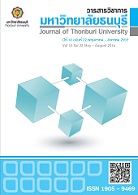ผลกระทบของปริมาณเงินที่มีต่ออัตราการเจริญเติบโตทางเศรษฐกิจของประเทศไทย
Keywords:
ผลกระทบ, ปริมาณเงิน, การเจริญเติบโตทางเศรษฐกิจ, Effect, Money Supply, Economic Growth,Abstract
ศึกษาครั้งนี้มีวัตถุประสงค์เพื่อศึกษาความสัมพันธ์ระหว่างปริมาณเงินต่ออัตราการเจริญเติบโตทางเศรษฐกิจของประเทศไทย โดยใช้ข้อมูลทุติยภูมิ (Secondary data) แบบอนุกรรมเวลา (Time Series data) แบบรายปีตั้งแต่ พ.ศ.2540 ถึง พ.ศ.2556 รวมระยะเวลาทั้งสิ้น 17 ปี มาทำการวิเคราะห์ผลกระทบของตัวแปรอิสระและตัวแปรตาม
ผู้ศึกษาได้แบ่งการศึกษาออกเป็น 4 ส่วน โดยเริ่มจากการทำการทดสอบคุณสมบัติความนิ่งของข้อมูลอนุกรมเวลา (Unit Root) โดยใช้วิธี Augmented Dick Fuller เพื่อทดสอบว่าข้อมูล ปริมาณเงินตามความหมายกว้าง (M2) รายได้ประชาชาติ ฐานเงิน ดุลบัญชีเดินสะพัด สินเชื่อภาคเอกชน ดัชนีราคาผู้บริโภค อัตราแลกเปลี่ยน อัตราดอกเบี้ยนโยบาย เงินฝากกระแสรายวันของธนาคารพาณิชย์ในประเทศไทย เงินฝากรวมของธนาคารพาณิชย์ในประเทศไทย สินเชื่อรวมของธนาคารพาณิชย์ในประเทศไทยและอัตราการเจริญเติบโตทางเศรษฐกิจของประเทศไทย มีลักษณะนิ่งหรือไม่ จากนั้นทำการทดสอบในส่วนที่สอง คือการทดสอบความสัมพันธ์เชิงดุลยภาพระยะยาว (Cointegration) เพื่อทดสอบความสัมพันธ์ของตัวแปรว่ามีความสัมพันธ์ในระยะยาวหรือไม่ แล้วจึงทดสอบส่วนที่สาม ด้วยวิธีการทดสอบความสัมพันธ์เชิงดุลยภาพในระยะสั้น (Error Correction Model : ECM) ว่าตัวแปรจะปรับตัวสู่ดุลยภาพเดิมหรือห่างจากดุลยภาพเดิม และทดสอบส่วนที่สี่ ทดสอบความเป็นเหตุเป็นผล (Granger Causality Test) เพื่อดูว่าตัวแปรใดเป็นต้นเหตุของการเปลี่ยนแปลงไปของอีกตัวแปรหนึ่ง
จากผลการทดสอบความนิ่ง (Unit root) พบว่าข้อมูลตัวแปรปริมาณเงินตามความหมายกว้าง อัตราการเจริญเติบโตทางเศรษฐกิจของประเทศไทย รายได้ประชาชาติ ฐานเงิน ดุลบัญชีเดินสะพัด สินเชื่อภาคเอกชน ดัชนีราคาผู้บริโภค อัตราแลกเปลี่ยน อัตราดอกเบี้ยนโยบาย เงินฝากกระแสรายวันของธนาคารพาณิชย์ในประเทศไทย เงินฝากรวมของธนาคารพาณิชย์ในประเทศไทย และสินเชื่อรวมของธนาคารพาณิชย์ในประเทศไทย มีลักษณะนิ่ง (Stationary) ที่ระดับ I (2)
จากผลการทดสอบความสัมพันธ์เชิงดุลยภาพในระยะยาว (Cointegration) ตามวิธีการของ Engle and Granger โดยการประมาณค่าสมการถดถอยด้วยวิธีกำลังสองน้อยที่สุด (OLS) และทำการทดสอบค่าความคลาดเคลื่อนจากสมการที่ประมาณได้ว่ามีลักษณะนิ่ง (Stationary) สามารถอธิบายได้ว่า การทดสอบความสัมพันธ์เชิงดุลยภาพระยะยาว (cointegration test) โดยใช้ค่าความคลาดเคลื่อน (residual) นำมาทดสอบยูนิทรูท (unit root test) โดยวิธี Augmented Dickey-Fuller (ADF) ที่ Order of Integration เท่ากับ 0 หรือ I(0) ที่ระดับ Level without Trend and Intercept ณ ช่วงเวลา (Lag) เท่ากับ 0 พบว่า ค่าสถิติ ADF ของ lnM2 (resid01), lnGPP (resid01) และ lnGDP (resid01) เท่ากับ -3.821321, -5.383433 และ -2.645522 ตามลำดับ ซึ่งมีค่ามากกว่าค่าวิกฤต ณ ระดับนัยสำคัญ 0.05 จึงปฏิเสธสมมติฐานหลัก แสดงว่าข้อมูลมีลักษณะนิ่ง (Stationary)
ดังนั้น สามารถอธิบายได้ว่า ตัวแปรอิสระทุกตัวกับตัวแปรตาม มีความสัมพันธ์ในเชิงดุลยภาพในระยะยาว หรือมีลักษณะ Co-integration
จากผลการทดสอบวิเคราะห์ความสัมพันธ์เชิงดุลยภาพระยะสั้น(Error-Correction Model : ECM) ความ สัมพันธ์ ระหว่างตัวแปร ปริมาณเงินตามความหมายกว้าง ซึ่ง เป็นตัวแปรอิสระ และอัตราการเจริญเติบโตทางเศรษฐกิจของประเทศไทย ซึ่งเป็นตัวแปรตาม พบว่าการเพิ่มขึ้นหรือลดลงของปริมาณเงินตามความหมายกว้าง ในระยะสั้น จะส่งผลให้อัตราการเจริญเติบโตทางเศรษฐกิจของประเทศไทยเปลี่ยนแปลงตามไปด้วย
จากการทดสอบการทดสอบความเป็นเหตุเป็นผล (Granger Causality Model) สมมติฐานปริมาณเงินตามความหมายกว้าง(M2) ไม่เป็นสาเหตุของ อัตราการเจริญเติบโตทางเศรษฐกิจของประเทศไทย และจากการทดสอบสมมติฐานอัตราการเจริญเติบโตทางเศรษฐกิจของประเทศไทย (GPP) ไม่เป็นสาเหตุของ ปริมาณเงินตามความหมายกว้าง(M2) สรุปได้ว่า ตัวแปรตาม และตัวแปรอิสระ มีความสัมพันธ์กันทั้งสองทิศทาง
ผลจากการวิเคราะห์ความสัมพันธ์ในครั้งนี้ พบว่าปริมาณเงินตามความหมายกว้างมีความสัมพันธ์กับตัวแปรทางเศรษฐกิจคือ สินเชื่อภาคเอกชน ดัชนีราคาผู้บริโภค และสินเชื่อรวมของธนาคารพาณิชย์ในประเทศไทย และยังได้พบว่าการเพิ่มขึ้นหรือลดลงของปริมาณเงินตามความหมายกว้าง ในระยะสั้น จะส่งผลทำให้อัตราการเจริญเติบโตทางเศรษฐกิจของประเทศไทย เปลี่ยนแปลงตามไปด้วย ข้อค้นพบนี้จะนำมาเป็นประโยชน์คือ จะใช้เป็นฐานข้อมูลเบื้องต้นสำหรับการศึกษาพัฒนาเศรษฐกิจ การกำหนดนโยบายการเงินให้สอดคล้องกับปริมาณเงิน ซึ่งส่งผลต่อการเจริญเติบโตทางเศรษฐกิจของประเทศไทยต่อไป
THE EFFECTS OF MONEY SUPPLY ON ECONOMIC GROWTH OF THAILAND
This research aims to study the relationship between money supply on Economic Growth Rate of Thailand by using secondary data in form of time series data annually since 1997 to 2013 totally 17 years to be analyzed the effects of independent variables and dependent variables.
The researcher had divided the study into 4 parts by starting from testing the stationary properties of time series data (Unit Root) by using Augmented Dick Fuller to test if the information of money supply in wide meaning, national income, balance on current account, private credit, consumer price index, exchange rate, policy interest rate, current account of the branches of commercial banks in Thailand, the total credit of the branches of commercial banks in Thailand, as well as Economic Growth Rate of Thailand were stationary or not. Then, testing in the second part, that is, the test of long-term equilibrium relationship (Cointegration) in order to test the relationship between the variables if they have long-termed relationship or not. Then, testing in the third part with the method of short-term equilibrium relationship (Error Correction Model: ECM) in order to determine if the variables will be adapted to the original equilibrium or distance from the original equilibrium. And testing in the fourth part with Granger Causality Test to determine if any variable is a cause of change in another variable.
From the test results of stationary properties (Unit root), it can be found that the information of the variables, money supply in wide meaning, national income, balance on current account, private credit, consumer price index, exchange rate, olicy interest rate, current account of the branches of commercial Banks in Thailand, as well as the total credit of the branches of commercial banks in Thailand were stationary at the level of I (2).
From the test results of long-termed equilibrium relationship (cointegration) as the methods of Engle and Granger by estimating the value of regression equation by using ordinary least squares (OLS) and testing the value of residual from estimated equations that are stationary, it can be described that test of long-term equilibrium relationship (Cointegration test) by using residual to conduct unit root test by Augmented Dickey-Fuller (ADF) that the value of Order of Integration was equal to 0 or I(0) at the level without Trend and Intercept at the lag 0, it can be found that the statistics values of ADF of lnM2 (resid01), lnGPP (resid01) and lnGDP (resid01) were equal to -3.821321, -5.383433 and -2.645522, respectively, which were greater than the critical value at the significance level of 0.05. Thus, we can reject the null hypothesis and conclude that the data was stationary.
Therefore, it can be described that all independent variables and dependent variables have long-termed equilibrium relationship or have the characters of cointegration.
From the analysis results of short-term equilibrium relationship (Error-Correction Model: ECM), the relationship between the variables, money supply in the wide meaning which are independent variables and economic growth rate of Thailand which was dependent variable, can be found that an increase or decrease of the money supply in the wide meaning of short term will contribute to the change of the economic growth rate of Thailand accordingly.
From the test results of granger causality model, the assumption of money supply in wide meaning (M2) was not a cause of Economic Growth of Thailand. And from the hypothesis testing, Economic Growth Rate of Thailand (GPP) was not a cause of money supply in wide meaning (M2). As a result, it can be concluded that independent variables and dependent variables have relationships in two directions.
The analysis results of this relationship could be found that money supply in the wide meaning has relationship with economic variables, namely, private credit, consumer price index and the total credit of the branches of commercial banks in Thailand. Also, it could be found that an increase or decrease of money supply in the wide meaning in short term will contribute to the change of the economic growth rate of Thailand as well. This finding will be beneficial as primary database for studying economic development and determining monetary policy to be in accordance with money supply which affects economic growth of Thailand.







